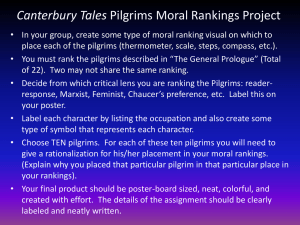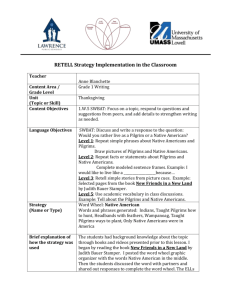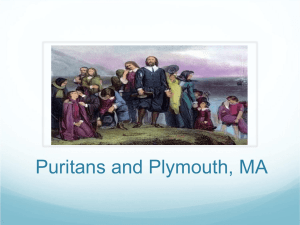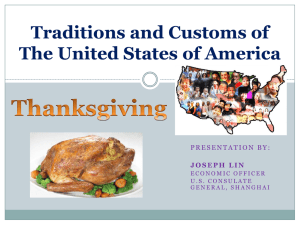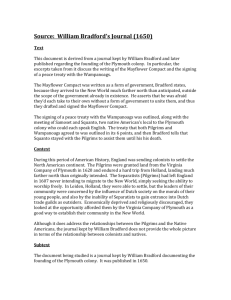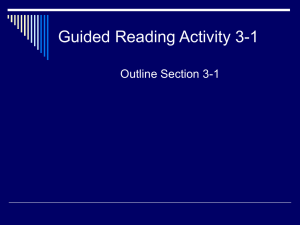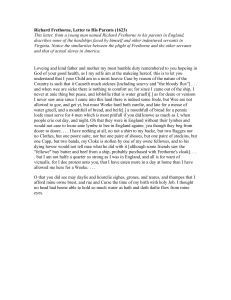View a formal project. If possible, submissions should come from
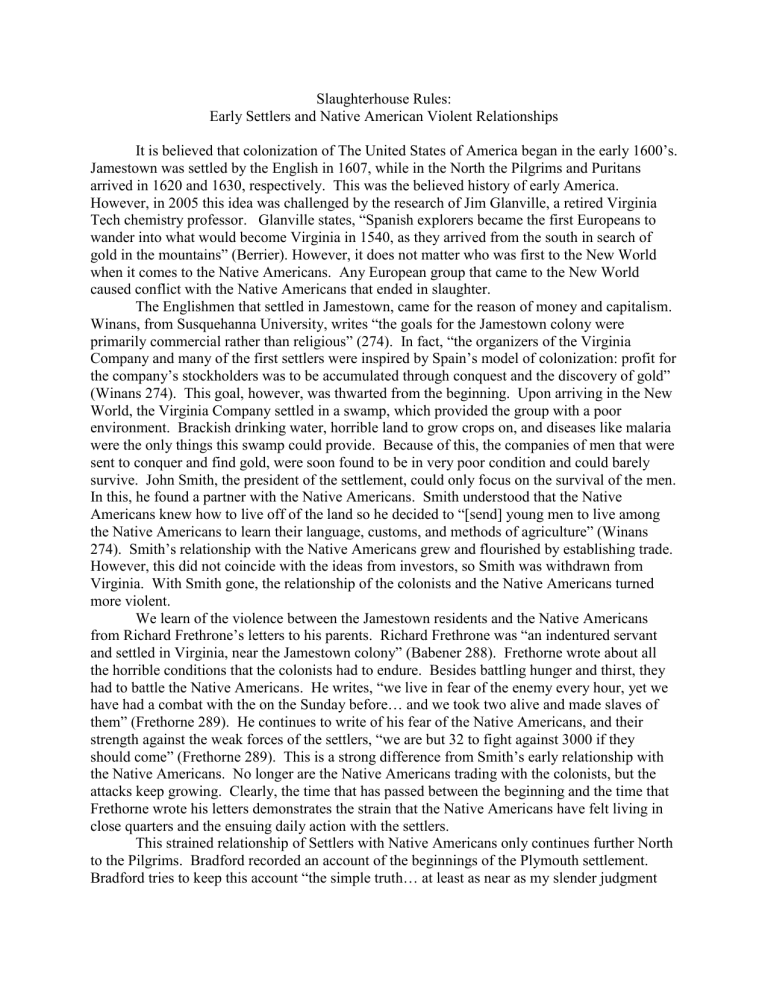
Slaughterhouse Rules:
Early Settlers and Native American Violent Relationships
It is believed that colonization of The United States of America began in the early 1600’s.
Jamestown was settled by the English in 1607, while in the North the Pilgrims and Puritans arrived in 1620 and 1630, respectively. This was the believed history of early America.
However, in 2005 this idea was challenged by the research of Jim Glanville, a retired Virginia
Tech chemistry professor. Glanville states, “Spanish explorers became the first Europeans to wander into what would become Virginia in 1540, as they arrived from the south in search of gold in the mountains” (Berrier). However, it does not matter who was first to the New World when it comes to the Native Americans. Any European group that came to the New World caused conflict with the Native Americans that ended in slaughter.
The Englishmen that settled in Jamestown, came for the reason of money and capitalism.
Winans, from Susquehanna University, writes “the goals for the Jamestown colony were primarily commercial rather than religious” (274). In fact, “the organizers of the Virginia
Company and many of the first settlers were inspired by Spain’s model of colonization: profit for the company’s stockholders was to be accumulated through conquest and the discovery of gold”
(Winans 274). This goal, however, was thwarted from the beginning. Upon arriving in the New
World, the Virginia Company settled in a swamp, which provided the group with a poor environment. Brackish drinking water, horrible land to grow crops on, and diseases like malaria were the only things this swamp could provide. Because of this, the companies of men that were sent to conquer and find gold, were soon found to be in very poor condition and could barely survive. John Smith, the president of the settlement, could only focus on the survival of the men.
In this, he found a partner with the Native Americans. Smith understood that the Native
Americans knew how to live off of the land so he decided to “[send] young men to live among the Native Americans to learn their language, customs, and methods of agriculture” (Winans
274). Smith’s relationship with the Native Americans grew and flourished by establishing trade.
However, this did not coincide with the ideas from investors, so Smith was withdrawn from
Virginia. With Smith gone, the relationship of the colonists and the Native Americans turned more violent.
We learn of the violence between the Jamestown residents and the Native Americans from Richard Frethrone’s letters to his parents. Richard Frethrone was “an indentured servant and settled in Virginia, near the Jamestown colony” (Babener 288). Frethorne wrote about all the horrible conditions that the colonists had to endure. Besides battling hunger and thirst, they had to battle the Native Americans. He writes, “we live in fear of the enemy every hour, yet we have had a combat with the on the Sunday before… and we took two alive and made slaves of them” (Frethorne 289). He continues to write of his fear of the Native Americans, and their strength against the weak forces of the settlers, “we are but 32 to fight against 3000 if they should come” (Frethorne 289). This is a strong difference from Smith’s early relationship with the Native Americans. No longer are the Native Americans trading with the colonists, but the attacks keep growing. Clearly, the time that has passed between the beginning and the time that
Frethorne wrote his letters demonstrates the strain that the Native Americans have felt living in close quarters and the ensuing daily action with the settlers.
This strained relationship of Settlers with Native Americans only continues further North to the Pilgrims. Bradford recorded an account of the beginnings of the Plymouth settlement.
Bradford tries to keep this account “the simple truth… at least as near as my slender judgment
Butler2 can attain the same” (350). His recordings show that the Pilgrims were under the same state as the Virginia Company: “In two or three month’s time half of their company died” (Bradford
355). The Pilgrims were relying on God getting them through the winter and when they encountered the Native Americans, they knew that they would have to only rely on God’s grace.
The Native Americans that the Pilgrims encountered were recorded as “reedier to fill their sides full of arrows” (Bradford 352-353). The Native Americans that were first encountered by the
Pilgrims were not pleased to see them. Bradford speaks of these Native Americans as the Pequot
Indians. These particular Native Americans assaulted the Pilgrims multiple times. One time
“the Pequot’s fell openly upon the English… and slew sundry of them as they were at work in the fields, both men and women, to the great terror of the rest and went away in great pride and triumph” (Bradford 362). This is further evidence that the Native Americans did not appreciate the Pilgrims in their territory and were taking action to provoke them. They may have been provoking them to leave or to fight back, so that the Native Americans could take the Pilgrims numbers down, yet again. Whatever the intent, the Pequots were definitely trying to provoke fear. The Pequots had also created enemies with another Indian tribe, the Narragansetts. The
Narragansetts looked to the English Pilgrims to help exact their revenge for the wrongs that the
Pequots had caused them both. So the Pilgrims and the Narragansetts raided and burned the
Pequot’s village. Bradford writes about this experience, “more were burnt to death than was otherwise slain” and “horrible was the stink and scent thereof; but the victory seemed a sweet sacrifice and they gave the praise thereof to God” (Bradford 364). The violence between the
Native Americans and the Pilgrims is further proof that no matter the locations of the European settlers, violence will ensue.
Another interaction with the Native Americans came with the Puritans and Thomas
Morton. Thomas Morton came to the New World in search of wealth. He accomplished his goal by selling rifles to the Native Americans. Not only was he making money off of this, Morton felt that he was also helping improve their way of life. Bradford writes: “First he taught them to how to use them, to charge and discharge, and what proportion of powder to give the piece, according to the size or bigness of the same and what shot to use for fowl and what for deer” (359). Having this knowledge would cause less time for the Native Americans to hunt for their living.
However, the Native Americans used the weapons, not just for hunting animals. They would use their newly acquired technology to hunt the Puritans. From the lines “how many both Dutch and
English have been lately slain by those Indians thus furnished and no remedy provided; nay, the evil more increased and the blood of their brethren sold for gain,” conclusions can be clearly drawn as to how Native Americans would use their new weapons—against the Puritan settlers
(Bradford 360). This interaction demonstrates that Morton was trying to implement his
European way of life into the Native American way of life, which causes violent conflict.
This cycle of violence between Settlers and Native Americans is only proven with the latest historical development. In a recent 2005 discovery, it has been found that the Spanish conquistadors were the first Europeans to actually enter Virginia. No longer is it true that
Jamestown residents were the first Europeans to enter Virginia. Virginia was invaded by
Hernando De Soto in search of gold in 1540. He sent two of his men, Juan de Villablosbos and
Francisco de Silvera, to go to the Appalachian Mountains. There, the Spanish set up “a colony called Santa Elena at Parris Islan, S.C.” The people from this colony left and make another settlement “and established Fort San Juan.” Fort San Juan was threatened by “native people[,] called the Chiscas.” The chief threatened, “he would come and eat them and a dog that the sergeant had.” Sgt. Moyano then took “15 to 20” soldiers and traveled “four days into the
Butler3 mountains” and found the Chiscas and started to kill them. It was said that the attack “was a slaughter,” which is similar to that of the Pilgrims attack on the Pequots. The Spanish “claimed to have killed 1,000 Indians and to have burned 50 huts.” Once again, the similarity can be drawn between the Pilgrims and the Spanish; both used fire to murder the Native Americans.
The conquistadors were no different than the other European settlers in their treatment of the
Native Americans. Moyano’s experiences with the Native Americans further prove the fact that the Europeans could not cohabitate with the Native Americans. (Berrier)
Of the four different early New World settlers, every group had some type of conflict with the Native Americans. It either was started by the Native Americans or it was instigated by the European settlers, but it was definitely a back-and-forth system of fighting. One group would threaten or kill some from the other, and the other group would retaliate. Peace could only be found in Jamestown. Yet by the time Frethrone wrote his letters, the Native Americans did not appreciate the Europeans settling in their territory. The result was the Native Americans would slaughter the settlers. The Pequots didn’t appreciate the Pilgrims settling in their area and the result was the Pilgrims slaughtering the Pequots, which is same for the rest of the settlers. It doesn’t matter who was first to the New World, where they came from, or why they came; whoever the Europeans were, where ever they went, violent conflict with the Native Americans ensued.
Cited:
Babener, Liahna. “Richard Frethorne fl.1623”
Heath Anthology of American Literature. Vol A:
Colonial Periods of 1800. Paul Landin, Gen. Ed. 6 th
Ed. Boston: Hougton Mifflin, 2009.
288
Bradford, John. “Of Plymouth Plantation.” Heath Anthology of American Literature. Vol A:
Colonial Periods of 1800. Paul Landin, Gen. Ed. 6 th
Ed. Boston: Hougton Mifflin, 2009.
350-370
Berrier, Ralph J. (2009). The Slaughter at Satlville. The Roanoke Times. Roanoke, Va. 981
3338.
Frethorne, Richard. “from Richard Frethorne, to His Parents.”
Heath Anthology of American
Literature. Vol A: Colonial Periods of 1800. Paul Landin, Gen. Ed. 6 th
Ed. Boston:
Hougton Mifflin, 2009. 288-291
Winans, Amy E. “John Smith 1580-1631.” Heath Anthology of American Literature. Vol A:
Colonial Periods of 1800. Paul Landin, Gen. Ed. 6 th
Ed. Boston: Hougton Mifflin, 2009.
273-275.
